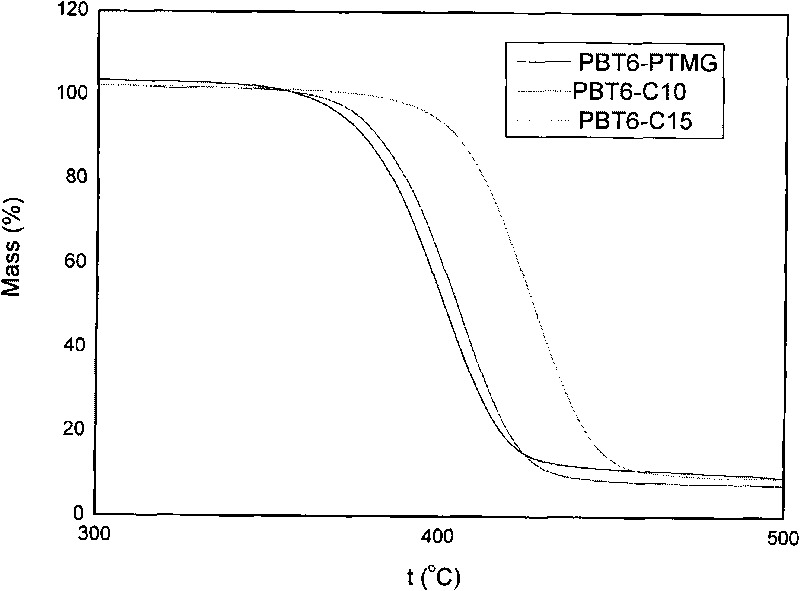Preparation method of copolyether ester
A technology of copolyetherester and transesterification, which is applied in the field of thermoplastic block copolyetherester elastomers, can solve the problems of difficult processing, high processing temperature, and the melting point of copolyetherester higher than 220°C, and achieve physical property changes and processability Excellent, melting point and crystallization rate lowering effects
- Summary
- Abstract
- Description
- Claims
- Application Information
AI Technical Summary
Problems solved by technology
Method used
Image
Examples
Embodiment 1
[0032] Weigh 970 grams of dimethyl terephthalate (DMT), 720 grams of 1,4-butanediol (BG), 1000 grams of polytetramethylene ether glycol (PTMG, molecular weight 1000), 144 grams of 1 , 4-cyclohexanedimethanol (CHDM, 10% total glycol mole fraction), 50ppm tetrabutyl titanate, 3065ppm antioxidant. Add part of dimethyl terephthalate (DMT) powder into the 5L reactor equipped with inlet and outlet, nitrogen inlet, condenser, agitator and fractionation column, turn on the heating, and then add the remaining materials into slurry . Gradually rise from room temperature to the range of 180-220°C, keep the temperature at the top of the fractionation column at 63-65°C, and when the amount of by-product methanol distilled out of the reaction kettle reaches more than 90% of the theoretical amount, start to reduce the pressure and heat up, and reduce the temperature in about 40 minutes. The pressure is reduced below 150Pa, while the temperature rises to 280-290°C. Keep this temperature and...
Embodiment 2
[0034] First weigh 776 grams of dimethyl terephthalate (DMT), 500 grams of 1,4-butanediol (BG), 185 grams of polytetramethylene ether glycol (PTMG, molecular weight 500, 5% total binary Alcohol mole fraction), 200 g 1,4-cyclohexanedimethanol (CHDM, 19% total glycol mole fraction), 32 ppm tetrabutyl titanate, 2625 ppm antioxidant. Add dimethyl terephthalate (DMT) powder into a 3L reaction kettle equipped with inlet and outlet, nitrogen inlet, condenser, stirrer and fractionation column, turn on the heating, and then add the slurry made of the remaining materials into . Gradually rise from room temperature to the range of 200-220°C, keep the temperature at the top of the fractionation column at 63-65°C, and when the amount of by-product methanol distilled out of the reactor reaches more than 90% of the theoretical amount, start to reduce the pressure and heat up, and reduce the temperature in about 40 minutes. The pressure is reduced below 130 Pa, while the temperature rises to...
Embodiment 3
[0036]Will weigh 776 grams of dimethyl terephthalate (DMT), 578 grams of 1,4-butanediol (BG), 264 grams of polytetramethylene ether glycol (PTMG, molecular weight 1500, 2% total di Alcohol mole fraction), 317 grams of 1,4-cyclohexanedimethanol (CHDM, 25% total glycol mole fraction), tetrabutyl titanate of 35ppm titanium, magnesium acetate of 25ppm, 2976ppm antioxidant The slurry is added into a 3L reactor equipped with inlet and outlet, nitrogen inlet, condenser, stirrer and fractionation column. Gradually raise the temperature of the reactor from room temperature to the range of 210-220°C, keep the top temperature of the fractionation column at 64-65°C, and when the amount of by-product methanol distilled out of the reactor reaches more than 90% of the theoretical amount, start to reduce the pressure and increase the temperature. Reduce the pressure to below 120Pa in about 40 minutes, and at the same time, raise the temperature to 280-290°C, continue the polycondensation reac...
PUM
 Login to View More
Login to View More Abstract
Description
Claims
Application Information
 Login to View More
Login to View More - R&D
- Intellectual Property
- Life Sciences
- Materials
- Tech Scout
- Unparalleled Data Quality
- Higher Quality Content
- 60% Fewer Hallucinations
Browse by: Latest US Patents, China's latest patents, Technical Efficacy Thesaurus, Application Domain, Technology Topic, Popular Technical Reports.
© 2025 PatSnap. All rights reserved.Legal|Privacy policy|Modern Slavery Act Transparency Statement|Sitemap|About US| Contact US: help@patsnap.com



